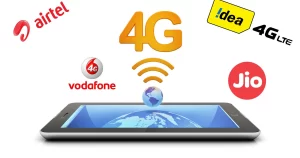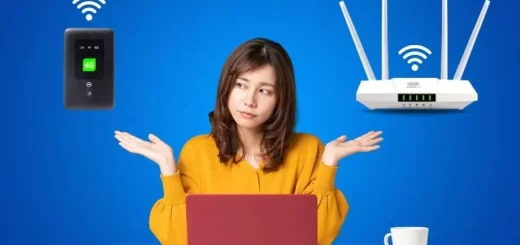4G Technology uses, features, advantages and disadvantages
4G LTE means fourth-generation long-term evolution, It aims to offer users faster, more reliable mobile broadband internet for devices such as smartphones, tablets, and laptops, Its speed is much faster than the 3G, so, if you are using it, you will not encounter slow or poor internet speed.
4G Technology
4G Technology is an up-and-coming technology, 4G stands for fourth-generation data download speeds, and 4G LTE is the 4th generation wireless mobile modern, With high data speed, 4G can reach 100Mbps, 150Mbps, and 300Mbps, and future will update to 1000Mbps, 4G mobile networks offer amazing speed and efficiency and they took the mobile market by storm.
4G network theoretically will have a higher data transfer rate than 3G networks, With the appropriate amount of spectrum and good network engineering, the 4G LTE network is very fast, The Long Term Evolution (LTE)-based network has the potential to reach 100 Mbps, while the WiMAX network can top out at 70 Mbps.
The people in society continue to demand quicker and easier access to their information, consumers are using 4G as a widespread wireless standard while the providers bolster the security aspects of their devices, The demand from the wireless society of today has found its solution to deliver their data as quickly as possible and it is fourth-generation technology.
How does 4G work?
4G network uses radio waves to transmit data between your device and a cellular network at much higher speeds than previous generations. However, it employs advanced technologies like:
- Orthogonal Frequency Division Multiplexing (OFDM): This technique divides data into multiple sub-channels, improving data transmission efficiency and resistance to interference, and improving signal reliability in challenging conditions.
- Multiple Input Multiple Output (MIMO): This technology uses multiple antennas to transmit and receive data simultaneously, boosting data rates and signal quality. Using multiple antennas, MIMO increases data transfer rates and improves signal quality.
Features of 4G
4G technology refers to the Fourth Generation and it is the fourth generation of mobile network technology. It’s a significant improvement over its predecessor, 3G, offering much faster data speeds, lower latency (delay), and better overall performance.
- High-speed data: Enjoy faster downloads, uploads, and streaming. The most noticeable improvement is speed.
- Low latency: Reduced latency means less delay between sending and receiving data. This is crucial for real-time applications like online gaming and video calls.
- Increased capacity: More users can connect to the network without compromising speed or quality. 4G can handle more users and devices simultaneously.
- Improved voice quality: Clearer and more reliable voice calls. Better signal penetration indoors and in rural areas.
- MIMO (Multiple Input Multiple Output) and OFDM (Orthogonal Frequency Division Multiplexing) can enhance signal quality and efficiency.
Applications of 4G
- Mobile Internet: Faster browsing, downloading, and streaming. Enjoy smooth, uninterrupted video content.
- Online gaming: Enjoy smooth gameplay without lag. Experience lag-free gaming on mobile devices.
- Video conferencing: High-quality video chats with minimal interruptions. Conduct high-quality video calls with multiple participants.
- Streaming: Watch HD videos and movies on the go.
- Cloud computing: You can access and store data in the cloud seamlessly
- Internet of Things (IoT): Supports the connectivity of various devices.
4G Technology advantages
4G wireless network is a pure data connection, It is an end-to-end Internet Protocol connection, The cellular providers have the opportunity to offer data access to a wide variety of devices, 4G technology provides mobility, It is more flexible, It is more reliable, It is easier to standardize and it offers affordability.
You can easily access the Internet, IM, Social Networks, streaming media, video calling, and other broadband services, It is very stable when connected to the Internet without any disruption and it doesn’t throttle.
WiMAX, LTE, and HSPA+ are all versions of 4G, WiMAX is used by Sprint, LTE is used by Verizon and AT&T, HSPA+ is used by AT&T and TMobile, 4G LTE network supports global access, the service portability and scalable mobile services, It supports IP based mobile system-High speed, high capacity and low cost per bit.
4G LTE network is very fast and 10 times faster than the 3G network, It offers extremely high voice quality, It is very fast when downloading huge files over a wireless network, It is very good and clear when streaming videos, watching online videos, playing online music, watching online TV and the others streaming stuff.
The younger generation of mobile device users can stream music, videos, and movies at a much faster rate than ever before and they can also easily share information online, 4G technology is affordable, It is more expensive than traditional Wi-Fi networks but it also has a lot more advantages to offer to the users.
4G mobile network offers amazing speed, It has higher bandwidth, and Increased bandwidth leads to much faster data transfer speed, which is especially advantageous for mobile devices, The users of the 4G network get the benefit of superior, uninterrupted connectivity, especially for the advanced tasks like video chats and conferences.
4G networks present much more coverage than other systems such as Wi-Fi, which forces the users to depend upon hotspots in each area they visit, Since 4G offers a coverage of 30 miles and more, as also overlapping network ranges, The users would be assured of complete connectivity at all times.
One of the biggest drawbacks of Wi-Fi networks is online security, This is especially true for mobile devices, 4G networks present complete privacy, security, and safety, This is especially beneficial for corporate establishments and business persons, who hold sensitive information on their respective mobile devices.
4G technology provides users with many options to choose from, Many mobile carriers offer special introductory offers for new customers, that work out to be very reasonable for them, Seamless switching and a variety of Quality of Better spectral efficiency, Service driven services, Better scheduling and call admission control techniques.
Enjoy seamless streaming, downloading, and browsing. Clearer and more reliable phone calls. Experience smoother gameplay with reduced lag. High-quality video calls with minimal interruptions.
4G Technology disadvantages
Obtaining information from people illegally becomes easier, 4G technology involves the possibility of some interference though not much, It is capable of being attacked (jamming frequencies) and the invasion of privacy increased.
The consumer is forced to buy a new device to support the 4G, New frequencies mean new components in the cell towers, Higher data prices for the consumers, Your current equipment can not be compatible with the 4G network, It has different network bands for different phones It is expensive and hard to implement.
4G LTE network has higher data prices for the consumers (expensive), The consumers are forced to buy a new device to support 4G LTE, It consumes a lot of battery when in use, It consumes the data very fast and your battery becomes hot when it is used for a very long time (like a microwave).
4G LTE network needs complex hardware, 4G technology is still limited to certain specified carriers and regions but the number of cities that have 4G coverage is increasing by the day, it would take its own time for this network to be available in all the major cities of the world.
Mobiles compatible with 4G network are cheaper than earlier but this new equipment would have to be installed to supply these services, it is a cumbersome process for most mobile carriers planning to launch these services, 4G mobile technology is still fairly new but it will most likely have its initial glitches and bugs, which could be quite annoying for the user.
4G technology uses many antennae and transmitters, You would experience much poorer battery life on your mobile, while on this network, So, you would have to use larger mobile devices with more battery power to be able to stay online for longer periods.
The users would be forced to use 3G or Wi-Fi connectivity in the areas that do not yet have 4G mobile network coverage, While this is a problem in itself, the worse issue is that they would still have to pay the same amount as specified by the 4G network plan, This situation can only be resolved once mobile carriers expand their 4G network coverage to include more regions.
4G technology requires expensive infrastructure for operation, This is embodied in the eNodeBs (Access Points) and mainly EPCs (Gateways or Routers), 4G is optimal for data rates, but not necessarily the best for Voice services, Some of these services are offloaded (delegated) to Wi-Fi or 3G/GSM cellular technologies on your phone.
The Rise of 5G
While 4G has revolutionized mobile technology, it’s gradually being replaced by 5G, which offers even faster speeds, lower latency, and greater capacity. However, 4G still provides reliable and fast connectivity for many users. It’s likely to remain a viable option for several years, especially in areas with limited 5G coverage.
5G network features, uses, importance, dangers, What is 5g technology and How it works?
3G Technology (third-generation technology) features and applications
2G technology uses, features, advantages & disadvantages
You can subscribe to Science Online on YouTube from this link: Science Online
You can download Science online application on Google Play from this link: Science online Apps on Google Play




